The Photoluminescence and Biocompatibility of CuInS2-Based Ternary Quantum Dots and Their Biological Applications
Abstract
:1. Introduction
2. Synthetic Strategies for CIS QDs
3. Tuning of Optical Properties of CIS QDs
4. Biological Evaluation of CIS-Based QDs
5. Conclusions and Future Outlook
Author Contributions
Funding
Conflicts of Interest
References
- Maluleke, R.; Sakho, E.H.M.; Oluwafemi, O.S. Aqueous synthesis of glutathione-capped CuInS2/ZnS quantum dots-graphene oxide nanocomposite as fluorescence “switch OFF” for explosive detection. Mater. Lett. 2020. [Google Scholar] [CrossRef]
- Jose Varghese, R.; Parani, S.; Adeyemi, O.O.; Remya, V.R.; Sakho, E.H.M.; Maluleke, R.; Thomas, S.; Oluwafemi, O.S. Green Synthesis of Sodium Alginate Capped -CuInS2 Quantum Dots with Improved Fluorescence Properties. J. Fluoresc. 2020. [Google Scholar] [CrossRef]
- Jose Varghese, R.; Parani, S.; Remya, V.R.; Maluleke, R.; Thomas, S.; Oluwafemi, O.S. Sodium alginate passivated CuInS2/ZnS QDs encapsulated in the mesoporous channels of amine modified SBA 15 with excellent photostability and biocompatibility. Int. J. Biol. Macromol. 2020. [Google Scholar] [CrossRef] [PubMed]
- Jawhar, N.N.; Soheyli, E.; Yazici, A.F.; Mutlugun, E.; Sahraei, R. Preparation of highly emissive and reproducible Cu–In–S/ZnS core/shell quantum dots with a mid-gap emission character. J. Alloys Compd. 2020, 824. [Google Scholar] [CrossRef]
- Sun, G.; Xing, W.; Xing, R.; Cong, L.; Tong, S.; Yu, S. Targeting breast cancer cells with a cuins2/ZnS quantum dot-labeled Ki-67 bioprobe. Oncol. Lett. 2018. [Google Scholar] [CrossRef] [Green Version]
- Ranjbar-Navazi, Z.; Omidi, Y.; Eskandani, M.; Davaran, S. Cadmium-free quantum dot-based theranostics. TrAC Trends Anal. Chem. 2019, 118, 386–400. [Google Scholar] [CrossRef]
- Allen, P.M.; Bawendi, M.G. Ternary I-III-VI quantum dots luminescent in the red to near-infrared. J. Am. Chem. Soc. 2008. [Google Scholar] [CrossRef] [PubMed] [Green Version]
- Pan, D.; An, L.; Sun, Z.; Hou, W.; Yang, Y.; Yang, Z.; Lu, Y. Synthesis of Cu-In-S ternary nanocrystals with tunable structure and composition. J. Am. Chem. Soc. 2008. [Google Scholar] [CrossRef] [PubMed]
- Ibáñez, M.; Zamani, R.; Li, W.; Shavel, A.; Arbiol, J.; Morante, J.R.; Cabot, A. Extending the nanocrystal synthesis control to quaternary compositions. Cryst. Growth Des. 2012. [Google Scholar] [CrossRef]
- Aldakov, D.; Lefrançois, A.; Reiss, P. Ternary and quaternary metal chalcogenide nanocrystals: Synthesis, properties and applications. J. Mater. Chem. C 2013. [Google Scholar] [CrossRef]
- Zhong, H.; Mirkovic, T.; Scholes, G.D. Nanocrystal Synthesis. In Comprehensive Nanoscience and Technology; Elsevier: Amsterdam, The Netherlands, 2011; pp. 153–201. ISBN 9780123743909. [Google Scholar]
- Zamani, R.R.; Ibáez, M.; Luysberg, M.; García-Castelló, N.; Houben, L.; Prades, J.D.; Grillo, V.; Dunin-Borkowski, R.E.; Morante, J.R.; Cabot, A.; et al. Polarity-driven polytypic branching in Cu-based quaternary chalcogenide nanostructures. ACS Nano 2014. [Google Scholar] [CrossRef] [PubMed]
- Lesnyak, V.; George, C.; Genovese, A.; Prato, M.; Casu, A.; Ayyappan, S.; Scarpellini, A.; Manna, L. Alloyed copper chalcogenide nanoplatelets via partial cation exchange reactions. ACS Nano 2014. [Google Scholar] [CrossRef] [PubMed]
- Chen, Y.; Li, S.; Huang, L.; Pan, D. Green and Facile Synthesis of Water-Soluble Cu–In–S/ZnS Core/Shell Quantum Dots. Inorg. Chem. 2013, 52, 7819–7821. [Google Scholar] [CrossRef] [PubMed]
- Mir, I.A.; Das, K.; Akhter, T.; Ranjan, R.; Patel, R.; Bohidar, H.B. Eco-friendly synthesis of CuInS2 and CuInS2@ZnS quantum dots and their effect on enzyme activity of lysozyme. RSC Adv. 2018. [Google Scholar] [CrossRef] [Green Version]
- Arshad, A.; Akram, R.; Iqbal, S.; Batool, F.; Iqbal, B.; Khalid, B.; Khan, A.U. Aqueous synthesis of tunable fluorescent, semiconductor CuInS2 quantum dots for bioimaging. Arab. J. Chem. 2019. [Google Scholar] [CrossRef] [Green Version]
- Van Der Stam, W.; Berends, A.C.; Rabouw, F.T.; Willhammar, T.; Ke, X.; Meeldijk, J.D.; Bals, S.; De Mello Donega, C. Luminescent CuInS2 quantum dots by partial cation exchange in Cu2−xS nanocrystals. Chem. Mater. 2015, 27, 621–628. [Google Scholar] [CrossRef]
- Tsolekile, N.; Nahle, S.; Zikalala, N.; Parani, S.; Sakho, E.H.M.; Joubert, O.; Matoetoe, M.C.; Songca, S.P.; Oluwafemi, O.S. Cytotoxicity, fluorescence tagging and gene-expression study of CuInS/ZnS QDS - meso (hydroxyphenyl) porphyrin conjugate against human monocytic leukemia cells. Sci. Rep. 2020, 10, 1–13. [Google Scholar] [CrossRef]
- Kolny-Olesiak, J.; Weller, H. Synthesis and application of colloidal CuInS2 semiconductor nanocrystals. ACS Appl. Mater. Interfaces 2013, 23, 12221–12237. [Google Scholar]
- Zhong, H.; Lo, S.S.; Mirkovic, T.; Li, Y.; Ding, Y.; Li, Y.; Scholes, G.D. Noninjection gram-scale synthesis of monodisperse pyramidal CuInS2 nanocrystals and their size-dependent properties. ACS Nano 2010. [Google Scholar] [CrossRef]
- Zhong, H.; Zhou, Y.; Ye, M.; He, Y.; Ye, J.; He, C.; Yang, C.; Li, Y. Controlled synthesis and optical properties of colloidal ternary chalcogenide CuInS2 nanocrystals. Chem. Mater. 2008, 20, 6434–6443. [Google Scholar] [CrossRef]
- Li, T.L.; Teng, H. Solution synthesis of high-quality CuInS2 quantum dots as sensitizers for TiO2 photoelectrodes. J. Mater. Chem. 2010. [Google Scholar] [CrossRef]
- Pan, D.; Wang, X.; Zhou, Z.H.; Chen, W.; Xu, C.; Lu, Y. Synthesis of quaternary semiconductor nanocrystals with tunable band gaps. Chem. Mater. 2009. [Google Scholar] [CrossRef]
- Bozyigit, D.; Wood, V. Challenges and solutions for high-efficiency quantum dot-based LEDs. MRS Bull. 2013. [Google Scholar] [CrossRef] [Green Version]
- De Trizio, L.; Prato, M.; Genovese, A.; Casu, A.; Povia, M.; Simonutti, R.; Alcocer, M.J.P.; D’Andrea, C.; Tassone, F.; Manna, L. Strongly fluorescent quaternary Cu-In-Zn-S nanocrystals prepared from Cu1−xInS2 nanocrystals by partial cation exchange. Chem. Mater. 2012. [Google Scholar] [CrossRef]
- Zhong, H.; Bai, Z.; Zou, B. Tuning the luminescence properties of colloidal I-III-VI semiconductor nanocrystals for optoelectronics and biotechnology applications. J. Phys. Chem. Lett. 2012. [CrossRef]
- Hong, G.; Antaris, A.L.; Dai, H. Near-infrared fluorophores for biomedical imaging. Nat. Biomed. Eng. 2017, 1, 1–22. [Google Scholar] [CrossRef]
- Batabyal, S.K.; Tian, L.; Venkatram, N.; Ji, W.; Vittal, J.J. Phase-selective synthesis of CuInS2 nanocrystals. J. Phys. Chem. C 2009. [Google Scholar] [CrossRef]
- Leach, A.D.P.; Mast, L.G.; Hernández-Pagán, E.A.; Macdonald, J.E. Phase dependent visible to near-infrared photoluminescence of CuInS2 nanocrystals. J. Mater. Chem. C 2015. [Google Scholar] [CrossRef] [Green Version]
- Wang, Y.; Zhao, X.; Liu, F.; Zhang, X.; Chen, H.; Bao, F.; Liu, X. Selective synthesis of cubic and hexagonal phase of CuInS2 nanocrystals by microwave irradiation. RSC Adv. 2014. [Google Scholar] [CrossRef]
- Ning, J.; Kershaw, S.V.; Rogach, A.L. Synthesis and Optical Properties of Cubic Chalcopyrite/Hexagonal Wurtzite Core/Shell Copper Indium Sulfide Nanocrystals. J. Am. Chem. Soc. 2019. [Google Scholar] [CrossRef]
- Yoshino, K.; Ikari, T.; Shirakata, S.; Miyake, H.; Hiramatsu, K. Sharp band edge photoluminescence of high-purity CuInS2 single crystals. Appl. Phys. Lett. 2001. [Google Scholar] [CrossRef]
- Torimoto, T.; Adachi, T.; Okazaki, K.I.; Sakuraoka, M.; Shibayama, T.; Ohtani, B.; Kudo, A.; Kuwabata, S. Facile synthesis of ZnS-AglnS2 solid solution nanoparticles for a color-adjustable luminophore. J. Am. Chem. Soc. 2007. [Google Scholar] [CrossRef] [PubMed]
- Liu, S.; Na, W.; Pang, S.; Shi, F.; Su, X. A label-free fluorescence detection strategy for lysozyme assay using CuInS2 quantum dots. Analyst 2014. [Google Scholar] [CrossRef]
- Liu, Z.; Ma, Q.; Wang, X.; Lin, Z.; Zhang, H.; Liu, L.; Su, X. A novel fluorescent nanosensor for detection of heparin and heparinase based on CuInS2 quantum dots. Biosens. Bioelectron. 2014. [Google Scholar] [CrossRef] [PubMed]
- Yu, Y.X.; Ouyang, W.X.; Liao, Z.T.; Du, B.B.; Zhang, W. De Construction of ZnO/ZnS/CdS/CuInS2 core-shell nanowire arrays via ion exchange: P-n junction photoanode with enhanced photoelectrochemical activity under visible light. ACS Appl. Mater. Interfaces 2014. [Google Scholar] [CrossRef]
- Xiao, J.; Xie, Y.; Tang, R.; Qian, Y. Synthesis and characterization of ternary CuInS2 nanorods via a hydrothermal route. J. Solid State Chem. 2001. [Google Scholar] [CrossRef]
- Castro, S.L.; Bailey, S.G.; Raffaelle, R.P.; Banger, K.K.; Hepp, A.F. Nanocrystalline chalcopyrite materials (CuInS2 and CuInSe2) via low-temperature pyrolysis of molecular single-source precursors. Chem. Mater. 2003, 15, 3142–3147. [Google Scholar] [CrossRef] [Green Version]
- Banger, K.K.; Harris, J.D.; Cowen, J.E.; Hepp, A.F. Facile modulation of single source precursors: The synthesis and characterization of single source precursors for deposition of ternary chalcopyrite materials. Thin Solid Films 2002, 403, 390–395. [Google Scholar] [CrossRef]
- Gardner, J.S.; Shurdha, E.; Wang, C.; Lau, L.D.; Rodriguez, R.G.; Pak, J.J. Rapid synthesis and size control of CuInS2 semi-conductor nanoparticles using microwave irradiation. J. Nanoparticle Res. 2008. [Google Scholar] [CrossRef]
- Kelly, C.V.; Jin, M.H.C.; Banger, K.K.; McNatt, J.S.; Dickman, J.E.; Hepp, A.F. Parametric study on non-vacuum chemical vapor deposition of CuInS2 from a single-source precursor. Mater. Sci. Eng. B Solid-State Mater. Adv. Technol. 2005, 116, 403–408. [Google Scholar] [CrossRef]
- Xia, C.; Winckelmans, N.; Prins, P.T.; Bals, S.; Gerritsen, H.C.; De Mello Donegá, C. Near-Infrared-Emitting CuInS2/ZnS Dot-in-Rod Colloidal Heteronanorods by Seeded Growth. J. Am. Chem. Soc. 2018. [Google Scholar] [CrossRef] [PubMed] [Green Version]
- Renuga, V.; Neela Mohan, C.; Manikandan, A. Influence of Mn2+ ions on both core/shell of CuInS2/ZnS nanocrystals. Mater. Res. Bull. 2018. [Google Scholar] [CrossRef]
- Niyamakom, P.; Quintilla, A.; Köhler, K.; Cemernjak, M.; Ahlswede, E.; Roggan, S. Scalable synthesis of CuInS2 nanocrystal inks for photovoltaic applications. J. Mater. Chem. A 2015. [Google Scholar] [CrossRef]
- Hua, J.; Cheng, H.; Yuan, X.; Zhang, Y.; Liu, M.; Meng, X.; Li, H.; Zhao, J. Photoluminescence quenching and electron transfer in CuInS2/ZnS core/shell quantum dot and FePt nanoparticle blend films. RSC Adv. 2015. [Google Scholar] [CrossRef]
- Hirpo, W.; Dhingra, S.; Sutorik, A.C.; Kanatzidis, M.G. Synthesis of Mixed Copper-Indium Chalcogenolates. Single-Source Precursors for the Photovoltaic Materials CuInQ2 (Q = S, Se). J. Am. Chem. Soc. 1993. [Google Scholar] [CrossRef]
- Banger, K.K.; Hollingsworth, J.A.; Harris, J.D.; Cowen, J.; Buhro, W.E.; Hepp, A.F. Ternary single-source precursors for polycrystalline thin-film solar cells. Appl. Organomet. Chem. 2002. [Google Scholar] [CrossRef]
- Nairn, J.J.; Shapiro, P.J.; Twamley, B.; Pounds, T.; Von Wandruszka, R.; Rick Fletcher, T.; Williams, M.; Wang, C.; Grant Norton, M. Preparation of ultrafine chalcopyrite nanoparticles via the photochemical decomposition of molecular single-source precursors. Nano Lett. 2006, 6, 1218–1223. [Google Scholar] [CrossRef]
- Li, L.; Daou, T.J.; Texier, I.; Chi, T.T.K.; Liem, N.Q.; Reiss, P. Highly luminescent cuins 2/ZnS Core/Shell nanocrystals: Cadmium-free quantum dots for in vivo imaging. Chem. Mater. 2009. [Google Scholar] [CrossRef]
- Pearson, R.G. Hard and Soft Acids and Bases. J. Am. Chem. Soc. 1963. [Google Scholar] [CrossRef]
- Chetty, S.S.; Praneetha, S.; Vadivel Murugan, A.; Govarthanan, K.; Verma, R.S. Microwave-Assisted Synthesis of Quasi-Pyramidal CuInS2–ZnS Nanocrystals for Enhanced Near-Infrared Targeted Fluorescent Imaging of Subcutaneous Melanoma. Adv. Biosyst. 2019. [Google Scholar] [CrossRef] [Green Version]
- Nose, K.; Soma, Y.; Omata, T.; Otsuka-Yao-Matsuo, S. Synthesis of ternary CuInS2 nanocrystals; phase determination by complex ligand species. Chem. Mater. 2009. [Google Scholar] [CrossRef]
- Han, S.; Kong, M.; Guo, Y.; Wang, M. Synthesis of copper indium sulfide nanoparticles by solvothermal method. Mater. Lett. 2009. [Google Scholar] [CrossRef]
- Yue, W.; Han, S.; Peng, R.; Shen, W.; Geng, H.; Wu, F.; Tao, S.; Wang, M. CuInS2 quantum dots synthesized by a solvothermal route and their application as effective electron acceptors for hybrid solar cells. J. Mater. Chem. 2010. [Google Scholar] [CrossRef]
- Xia, C.; Meeldijk, J.D.; Gerritsen, H.C.; De Mello Donega, C. Highly Luminescent Water-Dispersible NIR-Emitting Wurtzite CuInS2/ZnS Core/Shell Colloidal Quantum Dots. Chem. Mater. 2017, 29, 4940–4951. [Google Scholar] [CrossRef] [Green Version]
- su Kim, Y.; Lee, Y.; Kim, Y.; Kim, D.; Choi, H.S.; Park, J.C.; Nam, Y.S.; Jeon, D.Y. Synthesis of efficient near-infrared-emitting CuInS2/ZnS quantum dots by inhibiting cation-exchange for bio application. RSC Adv. 2017. [Google Scholar] [CrossRef] [Green Version]
- Macdonald, T.J.; Mange, Y.J.; Dewi, M.; McFadden, A.; Skinner, W.M.; Nann, T. Cation exchange of aqueous CuInS2 quantum dots. CrystEngComm 2014. [Google Scholar] [CrossRef]
- Jia, L.; Wang, Y.; Nie, Q.; Liu, B.; Liu, E.; Hu, X.; Fan, J. Aqueous-synthesis of CuInS2 core and CuInS2/ZnS core/shell quantum dots and their optical properties. Mater. Lett. 2017. [Google Scholar] [CrossRef]
- Tsolekile, N.; Ncapayi, V.; Parani, S.; Sakho, E.H.M.; Matoetoe, M.C.; Songca, S.P.; Oluwafemi, O.S. Synthesis of fluorescent CuInS2/ZnS quantum dots - Porphyrin conjugates for photodynamic therapy. MRS Commun. 2018. [Google Scholar] [CrossRef]
- Xi, Y.; Yang, J.; Ge, Y.; Zhao, S.; Wang, J.; Li, Y.; Hao, Y.; Chen, J.; Zhu, Y. One-pot synthesis of water-soluble near-infrared fluorescence RNase A capped CuInS2 quantum dots for: In vivo imaging. RSC Adv. 2017. [Google Scholar] [CrossRef] [Green Version]
- Chen, Y.; Li, S.; Huang, L.; Pan, D. Low-cost and gram-scale synthesis of water-soluble Cu–In–S/ZnS core/shell quantum dots in an electric pressure cooker. Nanoscale 2014, 6, 1295–1298. [Google Scholar] [CrossRef]
- Akdas, T.; Haderlein, M.; Walter, J.; Apeleo Zubiri, B.; Spiecker, E.; Peukert, W. Continuous synthesis of CuInS2 quantum dots. RSC Adv. 2017. [Google Scholar] [CrossRef] [Green Version]
- Wiles, C.; Watts, P. Continuous flow reactors, a tool for the modern synthetic chemist. European J. Org. Chem. 2008, 2008, 1655–1671. [Google Scholar] [CrossRef]
- Fitzmorris, R.C.; Oleksak, R.P.; Zhou, Z.; Mangum, B.D.; Kurtin, J.N.; Herman, G.S. Structural and optical characterization of CuInS2 quantum dots synthesized by microwave-assisted continuous flow methods. J. Nanoparticle Res. 2015. [Google Scholar] [CrossRef]
- Lee, J.; Han, C.S. Large-scale synthesis of highly emissive and photostable CuInS2/ZnS nanocrystals through hybrid flow reactor. Nanoscale Res. Lett. 2014. [Google Scholar] [CrossRef] [Green Version]
- Li, S.; Chen, Y.; Huang, L.; Pan, D. Simple continuous-flow synthesis of Cu-In-Zn-S/ZnS and Ag-In-Zn-S/ZnS core/shell quantum dots. Nanotechnology 2013. [Google Scholar] [CrossRef]
- Shestopalov, I.; Tice, J.D.; Ismagilov, R.F. Multi-step synthesis of nanoparticles performed on millisecond time scale in a microfluidic droplet-based system. Lab Chip 2004. [Google Scholar] [CrossRef] [Green Version]
- Yashina, A.; Lignos, I.; Stavrakis, S.; Choo, J.; Demello, A.J. Scalable production of CuInS2/ZnS quantum dots in a two-step droplet-based microfluidic platform. J. Mater. Chem. C 2016. [Google Scholar] [CrossRef]
- Kim, E.M.; Lim, S.T.; Sohn, M.H.; Jeong, H.J. Facile synthesis of near-infrared CuInS2/ZnS quantum dots and glycol-chitosan coating for in vivo imaging. J. Nanoparticle Res. 2017. [Google Scholar] [CrossRef]
- Park, J.; Kim, S.W. CuInS2/ZnS core/shell quantum dots by cation exchange and their blue-shifted photoluminescence. J. Mater. Chem. 2011. [Google Scholar] [CrossRef]
- Deng, C.; Fu, B.; Wang, Y.; Yang, L. Fabrication of Water-Soluble CuInS2 Quantum Dots by Hot-Injection Method and Phase Transfer Strategy. Nano 2018. [Google Scholar] [CrossRef]
- Kim, H.; Jang, H.S.; Kwon, B.H.; Suh, M.; Kim, Y.; Cheong, S.H.; Jeon, D.Y. In situ synthesis of thiol-capped CuInS2-ZnS quantum dots embedded in silica powder by sequential ligand-exchange and silanization. Electrochem. Solid-State Lett. 2012. [Google Scholar] [CrossRef]
- Zhao, C.; Bai, Z.; Liu, X.; Zhang, Y.; Zou, B.; Zhong, H. Small GSH-Capped CuInS2 Quantum Dots: MPA-Assisted Aqueous Phase Transfer and Bioimaging Applications. ACS Appl. Mater. Interfaces 2015. [Google Scholar] [CrossRef] [PubMed]
- Wang, Z.; Zhang, X.; Xin, W.; Yao, D.; Liu, Y.; Zhang, L.; Liu, W.; Zhang, W.; Zheng, W.; Yang, B.; et al. Facile Synthesis of Cu-In-S/ZnS Core/Shell Quantum Dots in 1-Dodecanethiol for Efficient Light-Emitting Diodes with an External Quantum Efficiency of 7.8%. Chem. Mater. 2018. [Google Scholar] [CrossRef]
- Chuang, P.H.; Lin, C.C.; Liu, R.S. Emission-tunable CuInS2/ZnS quantum dots: Structure, optical properties, and application in white light-emitting diodes with high color rendering index. ACS Appl. Mater. Interfaces 2014, 6, 15379–15387. [Google Scholar] [CrossRef]
- Xie, R.; Rutherford, M.; Peng, X. Formation of high-quality I#III#VI semiconductor nanocrystals by tuning relative reactivity of cationic precursors. J. Am. Chem. Soc. 2009, 131, 5691–5697. [Google Scholar] [CrossRef] [PubMed]
- Liu, S.; Zhang, H.; Qiao, Y.; Su, X. One-pot synthesis of ternary CuInS2 quantum dots with near-infrared fluorescence in aqueous solution. RSC Adv. 2012. [Google Scholar] [CrossRef]
- Zhang, J.; Sun, W.; Yin, L.; Miao, X.; Zhang, D. One-pot synthesis of hydrophilic CuInS2 and CuInS2-ZnS colloidal quantum dots. J. Mater. Chem. C 2014. [Google Scholar] [CrossRef]
- Zhang, C.; Xia, Y.; Lian, L.; Fu, X.; Yin, L.; Zhang, J.; Luo, W.; Miao, X.; Zhang, D. Dependence of the Photoluminescence of Hydrophilic CuInS2 Colloidal Quantum Dots on Cu-to-In Molar Ratios. J. Electron. Mater. 2019, 48, 286–295. [Google Scholar] [CrossRef]
- Peng, Z.A.; Peng, X. Nearly monodisperse and shape-controlled CdSe nanocrystals via alternative routes: Nucleation and growth. J. Am. Chem. Soc. 2002. [Google Scholar] [CrossRef]
- Yuan, Y.; Riehle, F.S.; Gu, H.; Thomann, R.; Urban, G.; Krüger, M. Critical parameters for the scale-up synthesis of quantum dots. J. Nanosci. Nanotechnol. 2010, 10, 6041–6045. [Google Scholar] [CrossRef]
- Joo, J.; Na, H.B.; Yu, T.; Yu, J.H.; Kim, Y.W.; Wu, F.; Zhang, J.Z.; Hyeon, T. Generalized and facile synthesis of semiconducting metal sulfide nanocrystals. J. Am. Chem. Soc. 2003. [Google Scholar] [CrossRef]
- Li, L.; Pandey, A.; Werder, D.J.; Khanal, B.P.; Pietryga, J.M.; Klimov, V.I. Efficient synthesis of highly luminescent copper indium sulfide-based core/shell nanocrystals with surprisingly long-lived emission. J. Am. Chem. Soc. 2011, 133, 1176–1179. [Google Scholar] [CrossRef] [PubMed]
- Niu, G.; Ruditskiy, A.; Vara, M.; Xia, Y. Toward continuous and scalable production of colloidal nanocrystals by switching from batch to droplet reactors. Chem. Soc. Rev. 2015. [Google Scholar] [CrossRef]
- Phillips, T.W.; Lignos, I.G.; Maceiczyk, R.M.; Demello, A.J.; Demello, J.C. Nanocrystal synthesis in microfluidic reactors: Where next? Lab Chip 2014. [Google Scholar] [CrossRef] [PubMed] [Green Version]
- Jensen, K.F.; Reizman, B.J.; Newman, S.G. Tools for chemical synthesis in microsystems. Lab Chip 2014. [Google Scholar] [CrossRef] [PubMed] [Green Version]
- Kim, H.; Suh, M.; Kwon, B.H.; Jang, D.S.; Kim, S.W.; Jeon, D.Y. In situ ligand exchange of thiol-capped CuInS2/ZnS quantum dots at growth stage without affecting luminescent characteristics. J. Colloid Interface Sci. 2011. [Google Scholar] [CrossRef] [PubMed]
- Tang, X.; Cheng, W.; Shi Guang Choo, E.; Xue, J. Synthesis of CuInS2-ZnS alloyed nanocubes with high luminescence. Chem. Commun. 2011. [Google Scholar] [CrossRef] [Green Version]
- Zhang, W.; Zhong, X. Facile synthesis of ZnS-CuInS2-alloyed nanocrystals for a color-tunable fluorchrome and photocatalyst. Inorg. Chem. 2011. [Google Scholar] [CrossRef]
- Zhang, J.; Xie, R.; Yang, W. A simple route for highly luminescent quaternary Cu-Zn-In-S nanocrystal emitters. Chem. Mater. 2011. [Google Scholar] [CrossRef]
- Uehara, M.; Watanabe, K.; Tajiri, Y.; Nakamura, H.; Maeda, H. Synthesis of CuInS2 fluorescent nanocrystals and enhancement of fluorescence by controlling crystal defect. J. Chem. Phys. 2008, 129. [Google Scholar] [CrossRef]
- Chen, B.; Zhong, H.; Zhang, W.; Tan, Z.; Li, Y.; Yu, C.; Zhai, T.; Bando, Y.; Yang, S.; Zou, B. Highly emissive and color-tunable CuInS2-based colloidal semiconductor nanocrystals: Off-stoichiometry effects and improved electroluminescence performance. Adv. Funct. Mater. 2012, 22, 2081–2088. [Google Scholar] [CrossRef]
- Yamamoto, T.; Luck, I.V.; Scheer, R.; Katayama-Yoshida, H. Differences in the electronic structure and compensation mechanism between n-type Zn- and Cd-doped CuInS2 crystals. Phys. B Condens. Matter 1999. [Google Scholar] [CrossRef]
- Zhang, S.; Wei, S.H.; Zunger, A.; Katayama-Yoshida, H. Defect physics of the chalcopyrite semiconductor. Phys. Rev. B Condens. Matter Mater. Phys. 1998. [Google Scholar] [CrossRef]
- Philip, R.R.; Pradeep, B. Structural analysis and optical and electrical characterization of the ordered defect compound CuIn5Se8. Semicond. Sci. Technol. 2003. [Google Scholar] [CrossRef]
- Fuhr, A.S.; Yun, H.J.; Makarov, N.S.; Li, H.; McDaniel, H.; Klimov, V.I. Light Emission Mechanisms in CuInS2 Quantum Dots Evaluated by Spectral Electrochemistry. ACS Photonics 2017. [Google Scholar] [CrossRef]
- Zhang, B.; Wang, Y.; Yang, C.; Hu, S.; Gao, Y.; Zhang, Y.; Wang, Y.; Demir, H.V.; Liu, L.; Yong, K.T. The composition effect on the optical properties of aqueous synthesized Cu-In-S and Zn-Cu-In-S quantum dot nanocrystals. Phys. Chem. Chem. Phys. 2015. [Google Scholar] [CrossRef]
- Hamanaka, Y.; Kuzuya, T.; Sofue, T.; Kino, T.; Ito, K.; Sumiyama, K. Defect-induced photoluminescence and third-order nonlinear optical response of chemically synthesized chalcopyrite CuInS2 nanoparticles. Chem. Phys. Lett. 2008. [Google Scholar] [CrossRef]
- Tsolekile, N.; Parani, S.; Vuyelwa, N.; Maluleke, R.; Matoetoe, M.; Songca, S.; Oluwafemi, O.S. Synthesis, structural and fluorescence optimization of ternary Cu–In–S quantum dots passivated with ZnS. J. Lumin. 2020. [Google Scholar] [CrossRef]
- Ma, J.; Liu, M.; Li, Z.; Li, L. Synthesis of highly photo-stable CuInS2/ZnS core/shell quantum dots. Opt. Mater. 2015. [Google Scholar] [CrossRef]
- Kays, J.C.; Saeboe, A.M.; Toufanian, R.; Kurant, D.E.; Dennis, A.M. Shell-Free Copper Indium Sulfide Quantum Dots Induce Toxicity in Vitro and in Vivo. Nano Lett. 2020. [Google Scholar] [CrossRef]
- Pons, T.; Pic, E.; Lequeux, N.; Cassette, E.; Bezdetnaya, L.; Guillemin, F.; Marchal, F.; Dubertret, B. Cadmium-free CuInS2/ZnS quantum dots for sentinel lymph node imaging with reduced toxicity. ACS Nano 2010, 4, 2531–2538. [Google Scholar] [CrossRef] [PubMed]
- Zhang, C.; Qu, G.; Sun, Y.; Wu, X.; Yao, Z.; Guo, Q.; Ding, Q.; Yuan, S.; Shen, Z.; Ping, Q.; et al. Pharmacokinetics, biodistribution, efficacy and safety of N-octyl-O-sulfate chitosan micelles loaded with paclitaxel. Biomaterials 2008. [Google Scholar] [CrossRef] [PubMed]
- Bhattarai, N.; Gunn, J.; Zhang, M. Chitosan-based hydrogels for controlled, localized drug delivery. Adv. Drug Deliv. Rev. 2010, 62, 83–99. [Google Scholar] [CrossRef] [PubMed]
- Deng, D.; Chen, Y.; Cao, J.; Tian, J.; Qian, Z.; Achilefu, S.; Gu, Y. High-quality CuInS2/ZnS quantum dots for in vitro and in vivo bioimaging. Chem. Mater. 2012. [Google Scholar] [CrossRef]
- Chen, C.W.; Wu, D.Y.; Chan, Y.C.; Lin, C.C.; Chung, P.H.; Hsiao, M.; Liu, R.S. Evaluations of the chemical stability and cytotoxicity of CuInS2 and CuInS2/ZnS core/shell quantum dots. J. Phys. Chem. C 2015. [Google Scholar] [CrossRef]
- Gerion, D.; Pinaud, F.; Williams, S.C.; Parak, W.J.; Zanchet, D.; Weiss, S.; Alivisatos, A.P. Synthesis and properties of biocompatible water-soluble silica-coated CdSe/ZnS semiconductor quantum dots. J. Phys. Chem. B 2001. [Google Scholar] [CrossRef] [Green Version]
- Hsu, J.C.; Huang, C.C.; Ou, K.L.; Lu, N.; Mai, F.D.; Chen, J.K.; Chang, J.Y. Silica nanohybrids integrated with CuInS2/ZnS quantum dots and magnetite nanocrystals: Multifunctional agents for dual-modality imaging and drug delivery. J. Mater. Chem. 2011. [Google Scholar] [CrossRef]
- Foda, M.F.; Huang, L.; Shao, F.; Han, H.Y. Biocompatible and highly luminescent near-infrared CuInS2/ZnS quantum dots embedded silica beads for cancer cell imaging. ACS Appl. Mater. Interfaces 2014. [Google Scholar] [CrossRef]
- Varghese, J.; Sakthipriya, P.; Rachel, G.; Ananthi, N. Polylactic acid coated SBA-15 functionalized with 3-aminopropyl triethoxysilane. Indian J. Chem. Sect. A Inorganic Phys. Theor. Anal. Chem. 2017, 56A, 621–625. [Google Scholar]
- Liu, Z.; Chen, N.; Dong, C.; Li, W.; Guo, W.; Wang, H.; Wang, S.; Tan, J.; Tu, Y.; Chang, J. Facile Construction of Near Infrared Fluorescence Nanoprobe with Amphiphilic Protein-Polymer Bioconjugate for Targeted Cell Imaging. ACS Appl. Mater. Interfaces 2015. [Google Scholar] [CrossRef]
- Sharma, V.K.; Gokyar, S.; Kelestemur, Y.; Erdem, T.; Unal, E.; Demir, H.V. Manganese doped fluorescent paramagnetic nanocrystals for dual-modal imaging. Small 2014. [Google Scholar] [CrossRef] [PubMed] [Green Version]
- Smith, A.M.; Nie, S. Bright and compact alloyed quantum dots with broadly tunable near-infrared absorption and fluorescence spectra through mercury cation exchange. J. Am. Chem. Soc. 2011. [Google Scholar] [CrossRef] [Green Version]
- Ma, Q.; Su, X. Near-infrared quantum dots: Synthesis, functionalization and analytical applications. Analyst 2010, 135, 1867–1877. [Google Scholar] [CrossRef] [PubMed]
- Shen, J.; Li, Y.; Zhu, Y.; Yang, X.; Yao, X.; Li, J.; Huang, G.; Li, C. Multifunctional gadolinium-labeled silica-coated Fe3O4 and CuInS2 nanoparticles as a platform for in vivo tri-modality magnetic resonance and fluorescence imaging. J. Mater. Chem. B 2015. [Google Scholar] [CrossRef] [PubMed]
- Zhang, J.; Hao, G.; Yao, C.; Hu, S.; Hu, C.; Zhang, B. Paramagnetic albumin decorated CuInS2/ZnS QDs for CD133+ glioma bimodal MR/fluorescence targeted imaging. J. Mater. Chem. B 2016. [Google Scholar] [CrossRef]
- Tsolekile, N.; Ncapayi, V.; Obiyenwa, G.K.; Matoetoe, M.; Songca, S.; Oluwafemi, O.S. Synthesis of meso-tetra-(4-sulfonatophenyl) porphyrin (TPPS4)—CuInS/ZnS quantum dots conjugate as an improved photosensitizer. Int. J. Nanomed. 2019. [Google Scholar] [CrossRef] [Green Version]
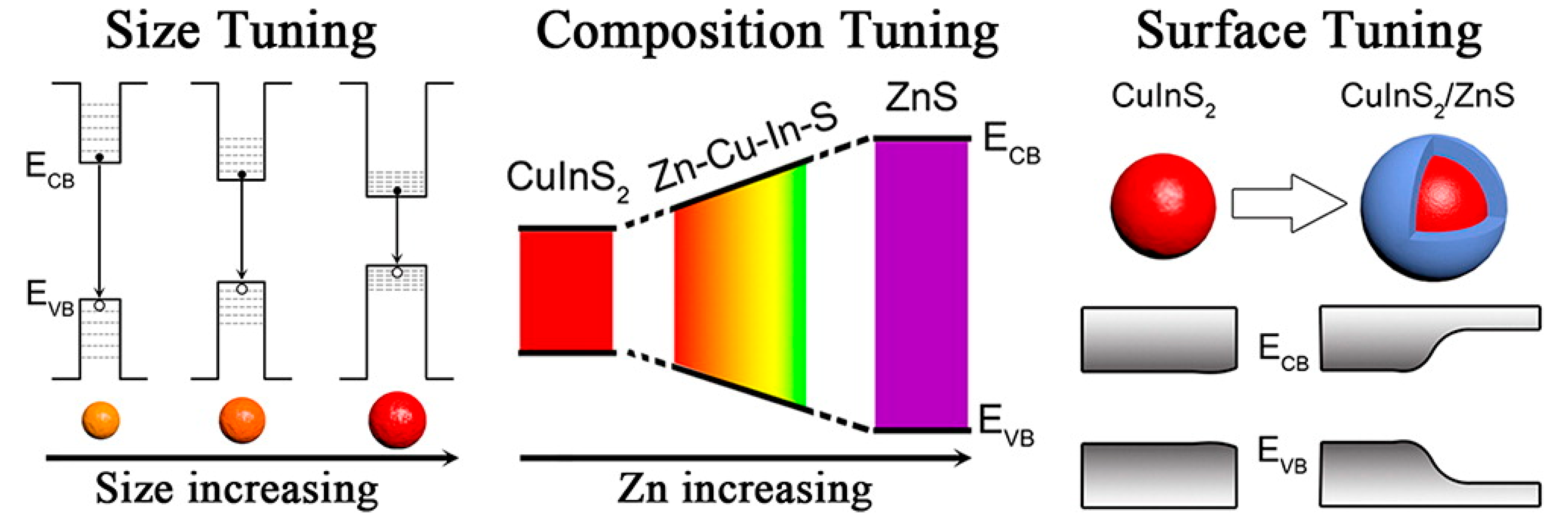
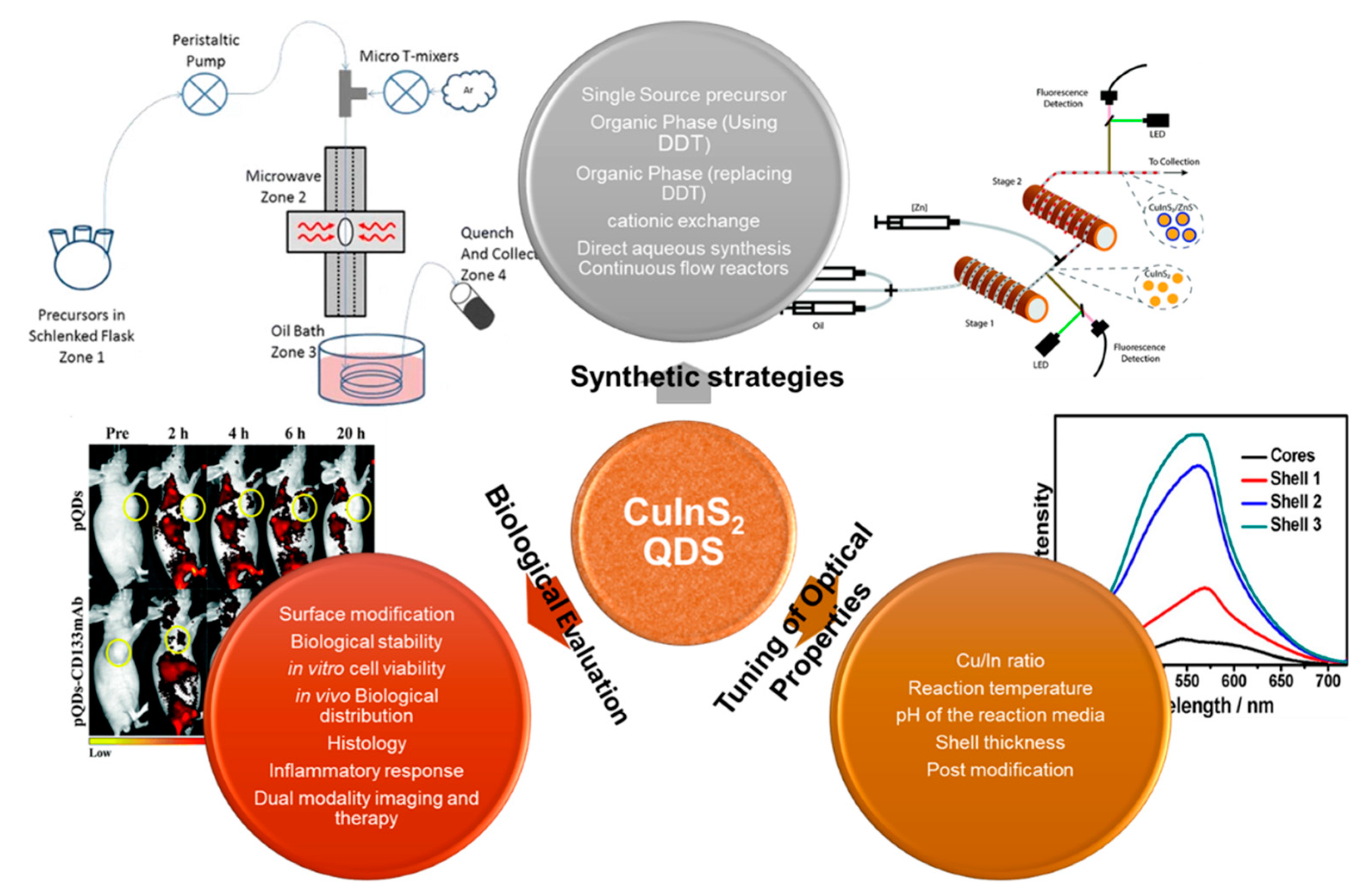
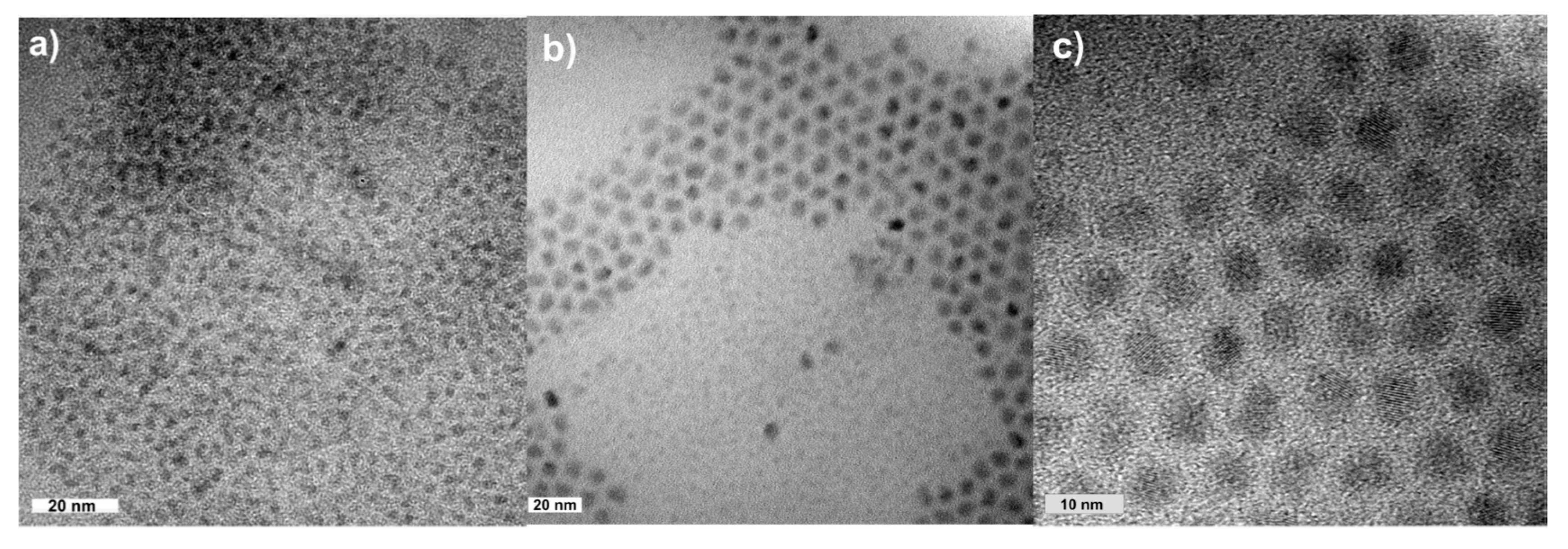





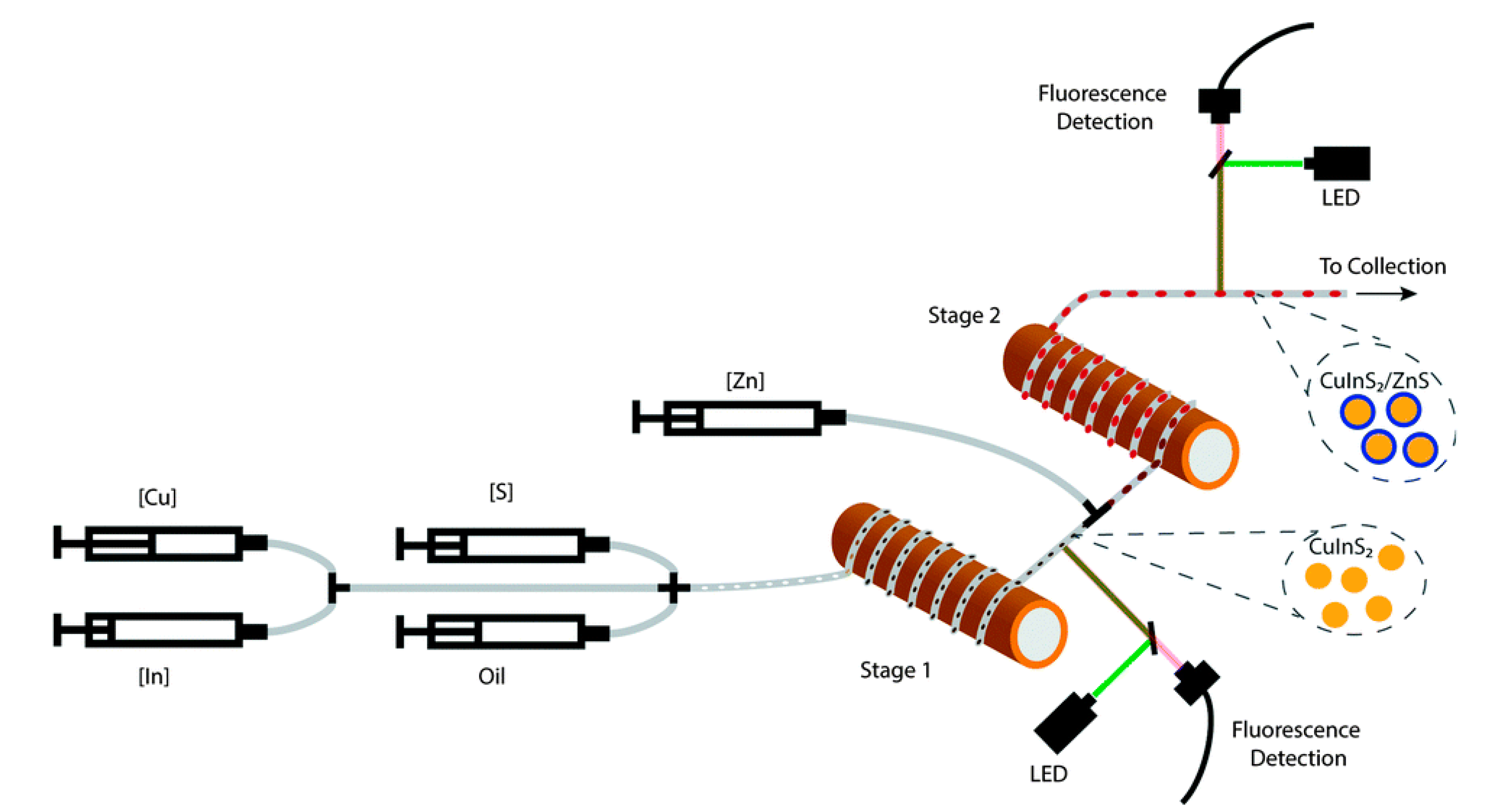


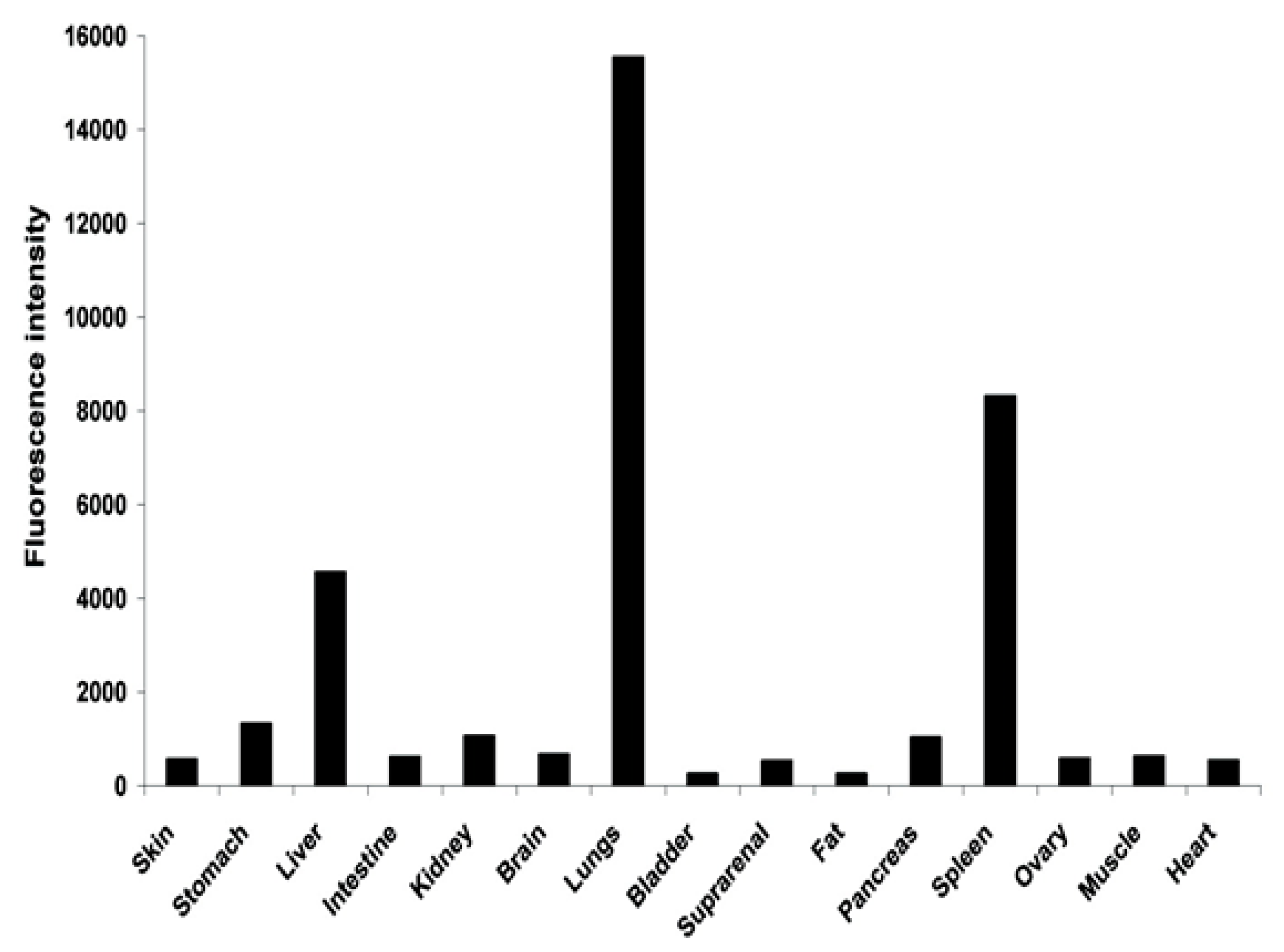
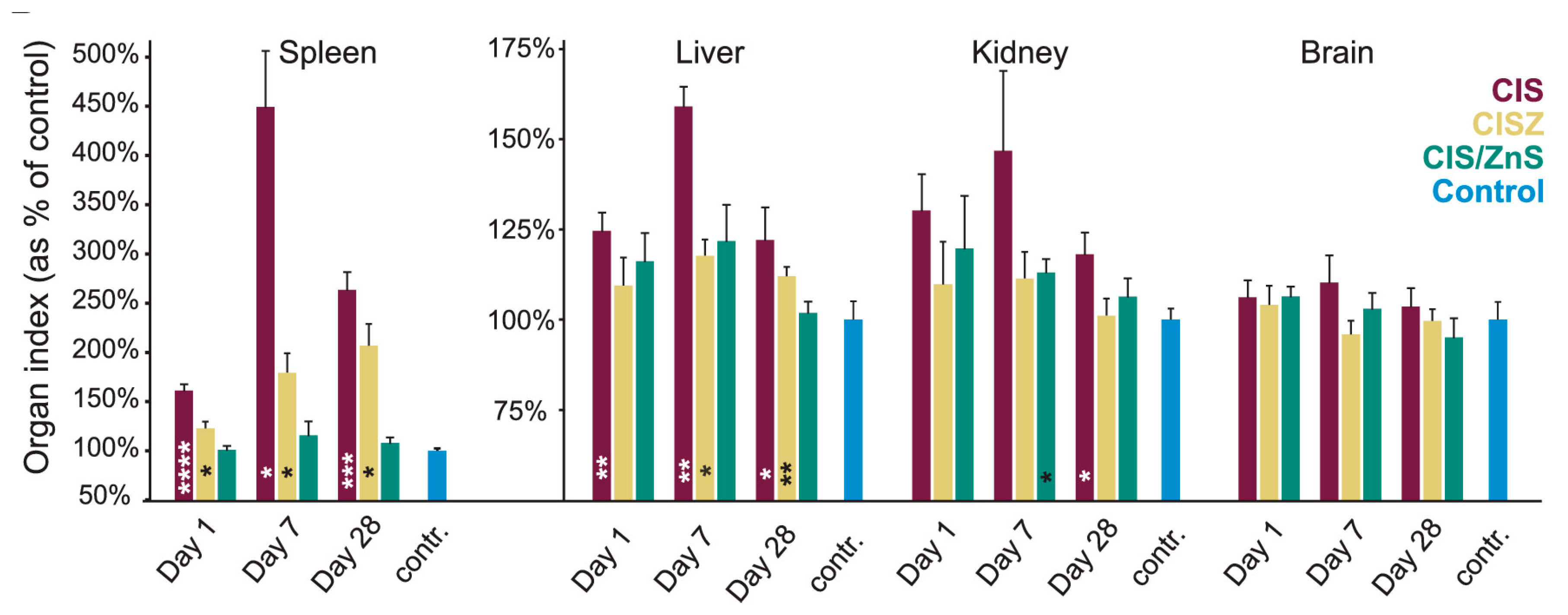







| Advantages | Disadvantages | Ref | |
|---|---|---|---|
| Single source precursor | Straight forward | Air sensitivity Expensive precursor High reaction temperature | [28,38,39,40,41] |
| Organic phase (using dodecanethiol (DDT)) | Monodisperse High quantum yield(QY) DDT can act as both a stabilizer and a sulfur source | High reaction temperature (>230 °C) Toxic reagents | [20,21,49,50,51] |
| Organic phase (replacing DDT) | Low reaction temperature (~150 °C) Burst nucleation of the core at lower temperature | Toxic reagents | [8,22,52,53,54] |
| Seed mediated cationic exchange | Emission position can be easily tuned to 870 nm | Lower PLQY(<1%) Complex procedure | [17,55] |
| Direct aqueous synthesis (hydrothermal/reflux) | Low toxic reagents Low reaction temperature (60–150 °C) Water soluble (no further phase transfer required) | Low PLQY (2–5%) Difference in reactivity between Cu+ and In3+ is very high Requirement of dual stabilizer (most cases) | [14,15,16,56,57,58,59,60,61] |
| Continuous flow reactors | Large scale production Minimize the clogging control over the nucleation and growth stage | Expensive | [62,63,64,65,66,67,68] |
Publisher’s Note: MDPI stays neutral with regard to jurisdictional claims in published maps and institutional affiliations. |
© 2020 by the authors. Licensee MDPI, Basel, Switzerland. This article is an open access article distributed under the terms and conditions of the Creative Commons Attribution (CC BY) license (http://creativecommons.org/licenses/by/4.0/).
Share and Cite
Jose Varghese, R.; Oluwafemi, O.S. The Photoluminescence and Biocompatibility of CuInS2-Based Ternary Quantum Dots and Their Biological Applications. Chemosensors 2020, 8, 101. https://doi.org/10.3390/chemosensors8040101
Jose Varghese R, Oluwafemi OS. The Photoluminescence and Biocompatibility of CuInS2-Based Ternary Quantum Dots and Their Biological Applications. Chemosensors. 2020; 8(4):101. https://doi.org/10.3390/chemosensors8040101
Chicago/Turabian StyleJose Varghese, Rajendran, and Oluwatobi Samuel Oluwafemi. 2020. "The Photoluminescence and Biocompatibility of CuInS2-Based Ternary Quantum Dots and Their Biological Applications" Chemosensors 8, no. 4: 101. https://doi.org/10.3390/chemosensors8040101





